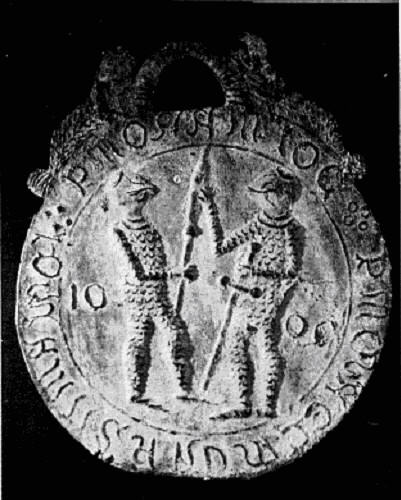|
was the principal owner and vendor of the objects described.
The case, which was held at Guildford assizes on 4th August
1858, was unique in English legal history in that it arose from
a meeting of an archaeological society. Archaeologists have
appeared as expert witnesses in court, but this case sought to
determine the implications of an archaeologist's expert opinion.
George Eastwood was first to testify. He said that he had paid
William Edwards £296 for 1100 of the objects before taking his
custom direct to Billy and Charley, paying them £50 for more
finds. He had believed them to be children's toys, but he now
thought they were pilgrims' signs.
William Edwards said
that Billy and Charley had first brought the objects to him in
June 1857, and supplied him with 1100, eight or ten at a time
over the next year, for which he had paid them £200. He did not
think he would easily let himself be taken in by his own
suppliers. When asked what the finds could be he replied that he
considered that a matter for the archaeological societies to
decide.
Charley Eaton had recently married, and his wife
would not let him attend the court. But Billy Smith did appear.
Described by a reporter covering the trial as "a rough looking
young man", he said that with Charley he had found 2000 of the
objects, making £400 from their sale. They bribed dock workers
to smuggle them out for free drinks, or searched the docks for
them after working hours (both of which, he was forced to admit,
were against port authority regulations).
Expert
witnesses were then called. Charles Roach Smith attended the
court unwillingly, upset that matters had come to such an end,
and uncertain that legal action would yield satisfactory results13.
Nonetheless, he reiterated his belief that the objects were
genuine. The Rev. Thomas Hugo said that he too believed them to
be late medieval. But when pressed to explain why, they both
said that their reasons were purely intuitive. Frederick
Fairholt, the archaeological illustrator, and two other antique
dealers, also vouched for the authenticity of the finds.
Here the prosecution rested its case. The defence claimed that
there was no case to answer, as there was no evidence that
George Eastwood had even been alluded to in the article under
discussion. The judge agreed, and directed the jury to return a
verdict of not guilty, although the defence was asked to affirm
its faith in George Eastwood's integrity.
13. T.B.A.C.
4th Aug. 1858; British Library, Additional Mss. 30297, item 270.
14.T.B.A.C. 22nd Dec. 1858.
|
 Fig. 4: a
medallion showing two typical Billy and Charley knights.
(Courtesy Cuming Museum)
Henry Syer Cuming was delighted. "We gained a glorious
victory" he wrote to Thomas Bateman; "How are the mightly
fallen!"14
He had even obtained the admission of an accomplice of Billy and
Charley that he had made "scores" of the objects, taking designs
from the Journal of the British Archaeological Association
and Charles Roach Smith's Collectanea Antiqua. If this
confession had been produced in court it might have ended the
debate, and it is strange that he made no further use of it. It
is also puzzling as to how Billy and Charley could have obtained
copies of Collectanea Antiqua, which raises the
possibility that they had collaborated with more highly placed
figures.
The Times devoted a column and a half to the tria15.
Athenaeum reprinted this with an introduction deploring
George Eastwood's conduct16, and The Literary
Gazette
did the same, adding an introduction sympathetic to
Athenaeum17.
Charles Roach Smith was more sympathetic to George Eastwood.
"We proved the genuineness of the finds and we could do no more"
he wrote to Thomas Hugo. He even offered to help pay his legal
15. 6th August 1858 12.
16. 7th August 1858
169-70.
17.7th August 1858 184-5.
|
